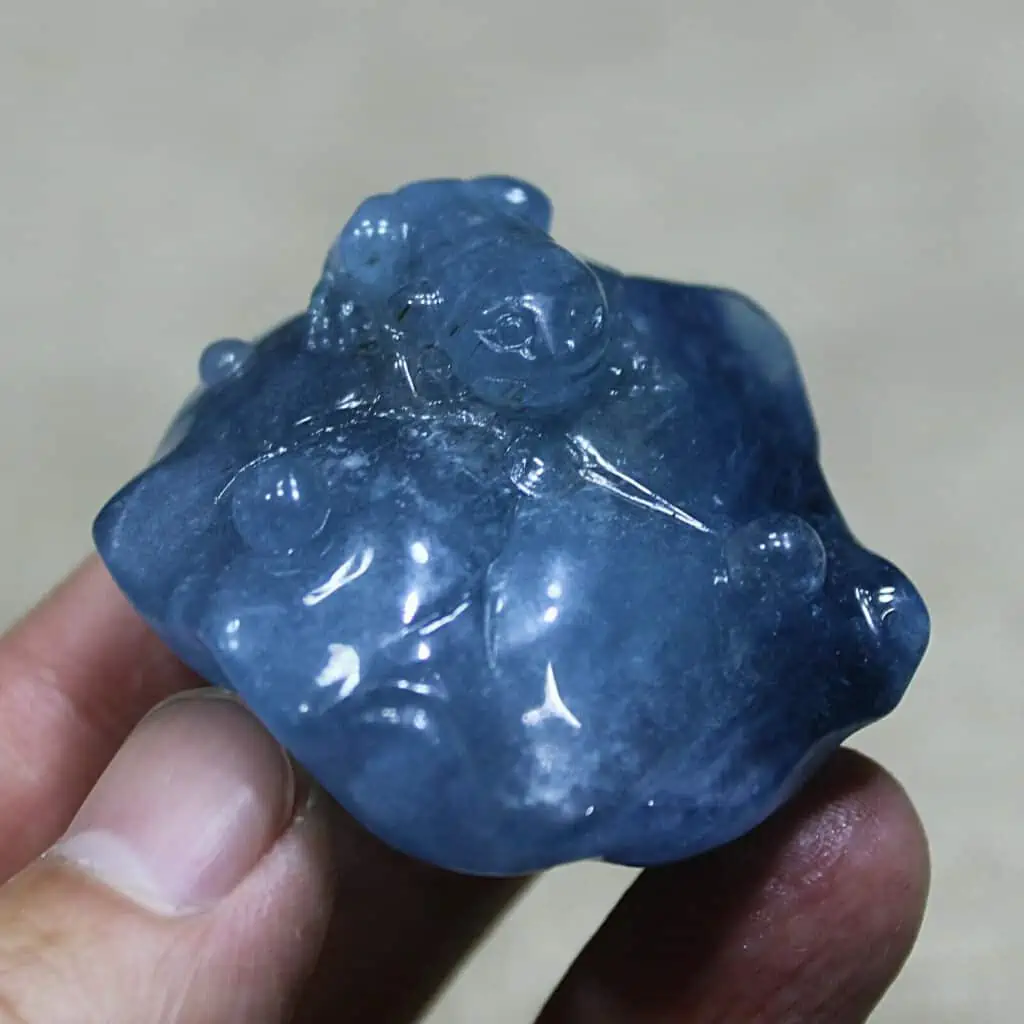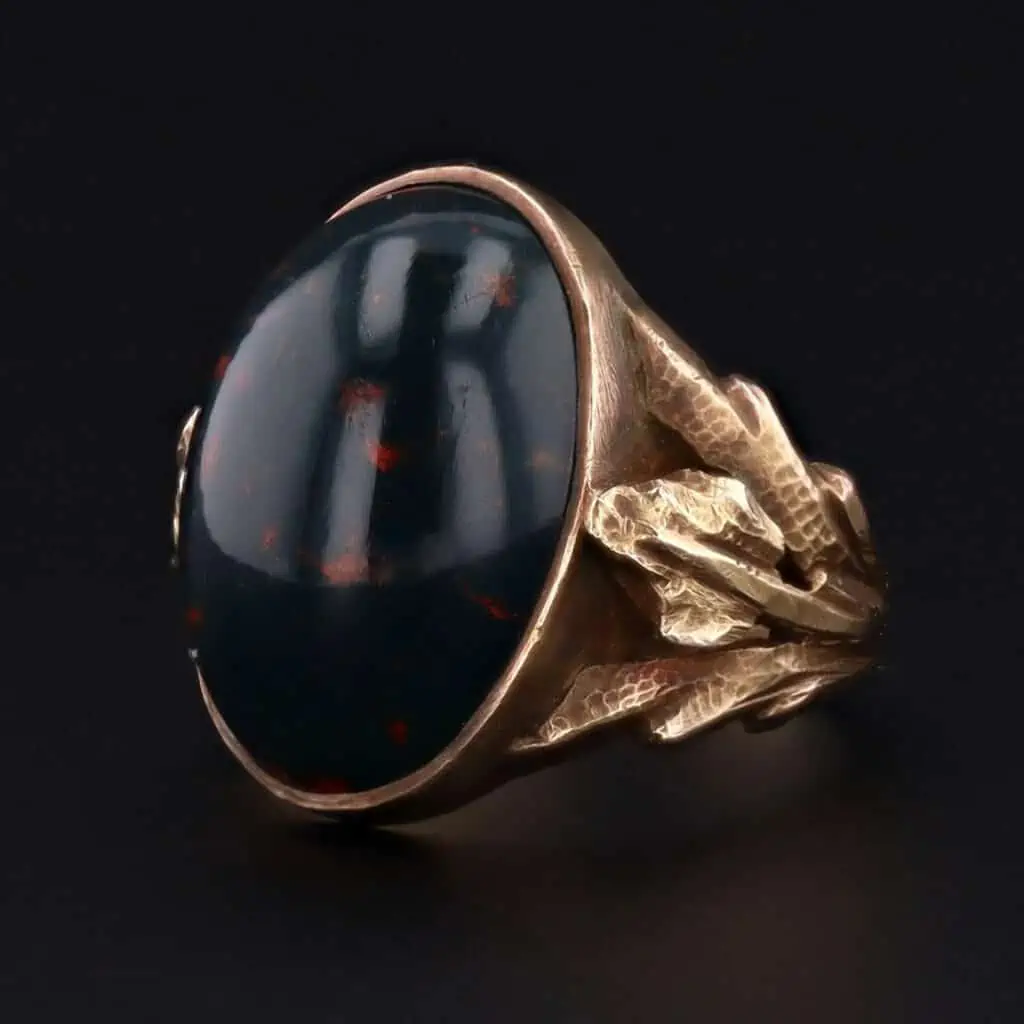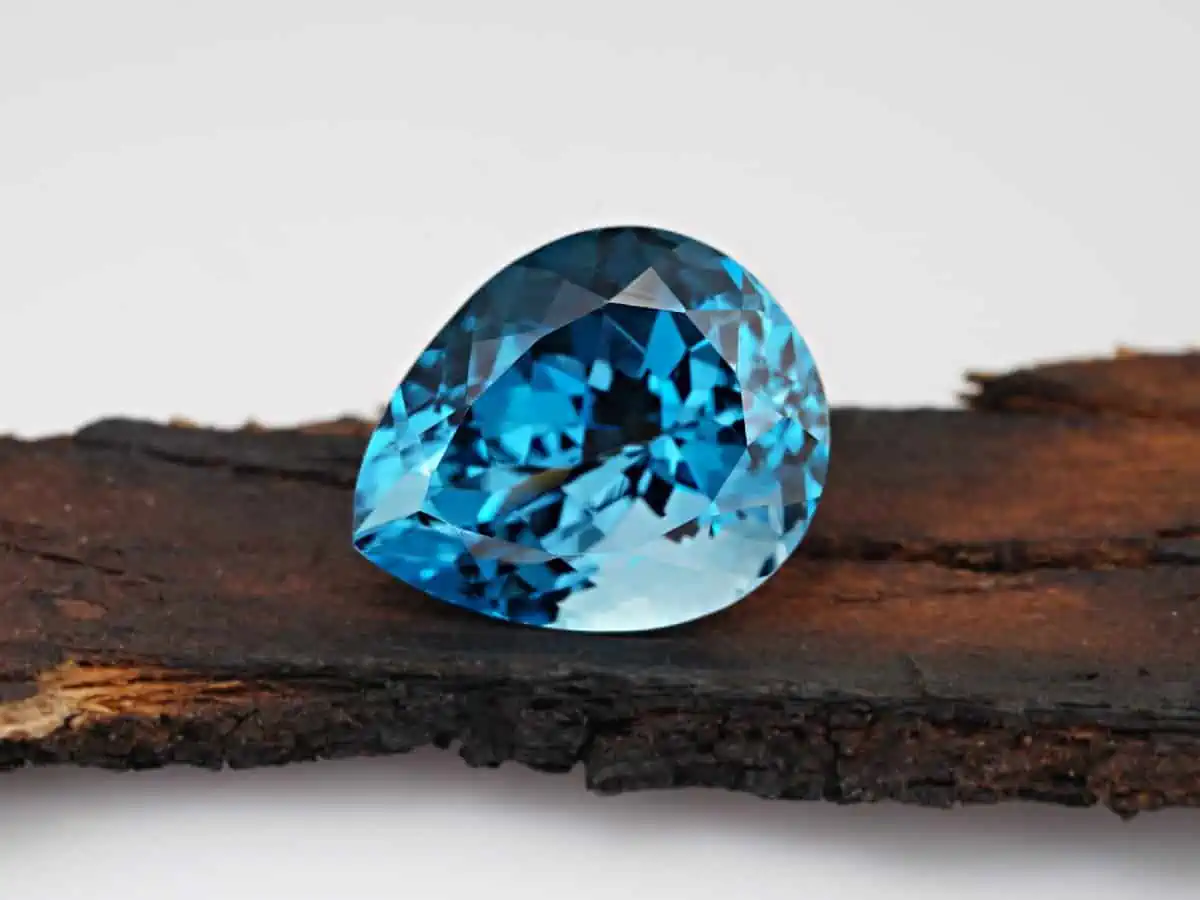Note from the Nomad: I’m a yogi, not a doctor! Any information provided here about the healing properties of crystals is based on historical or traditional beliefs and is not intended as medical advice; always consult a healthcare professional for medical concerns.
March babies get to choose between the unique and traditional beauty of this month’s two birthstones, Aquamarine and Bloodstone. Both gems might be different in appearance, but they are equally captivating. So even if you are not born in March, the stones can still be your favorite everyday jewelry.
March’s birthstones share more than just the month’s enchanting beauty. They are also rich in legends, lore, and healing powers. Here is why these gems are perfect gifts for yourself or your loved ones.
Contents
- 1 Why are Two Birthstones assigned to March?
- 2 Primary March Birthstone Aquamarine
- 3 The Aquamarine Birthstone History and Legends
- 4 Aquamarine Characteristics
- 5 How to Take Care of Your Aquamarine
- 6 Famous Aquamarine Birthstones
- 7 Aquamarine Metaphysical Properties
- 8 Secondary March Birthstone – Bloodstone
- 9 Bloodstone History and Legends
- 10 Bloodstone Characteristics
- 11 Bloodstone Metaphysical Properties
- 12 How to Take Care of Your Bloodstone
- 13 FAQ
Why are Two Birthstones assigned to March?
Although you might think of Aquamarine in the beginning as the traditional March birthstone, this place was reserved for the Bloodstone. The change was made by the National Association of Jewellers due to the lack of availability of the stone and consumers asking to have more choices. Therefore Aquamarine was added as the ideal accessible and affordable alternative. So now, the selection is much wider for everyone born in March and lovers of stunning gemstones.
Primary March Birthstone Aquamarine
| AQUAMARINE | |
|---|---|
| Nickname | The Sailor's Stone |
| Appearance |  |
| Benefits and healing properties | 1. Soothing - Calms emotions, reduces stress 2. Communication - Enhances clear expression, resolves misunderstandings 3. Protective - Shields against harm, safe travel over water |
| Protects against | 1. Stress - Promotes calming, reduces tension 2. Communication Issues - Enhances clear expression 3. Fear of Water - Traditionally believed to protect sailors |
| Associated chakra | Throat Chakra, Enhances clear communication, soothes fears. |
| Associated birth month and zodiac sign | March (Pisces, Aries) |
| Physical characteristics | Color: Blue-green Structure: Hexagonal crystal system Mineral Class: Beryl Hardness (Mohs Scale): 7.5 - 8 |
| Region(s) commonly found in | Brazil, Ural Mountains of Russia, Columbia, Island of Malagasy, India, Colorado (USA) |
| Alternate spellings & misspellings | aquamarine, aquamarina, aquamareen, aquamarne, aquamrine |
| Where to buy and learn more | See latest price |
With its unique blue-green color, the “Stone of the sea” Aquamarine quickly became a favorite among other birthstones. Who wouldn’t want a piece of the sea, wearing it as birthstone jewelry and making an impression everywhere they appear?
The light blue color of Aquamarine gems reminds us of summer and shimmering seawater. In addition, the precious gemstone became a symbol of purity, peacefulness, protection, and mental clarity. Furthermore, from Ancient times to this day, the Aquamarine March Birthstone’s healing properties are believed to be incredibly powerful and robust.
The Aquamarine Birthstone History and Legends
The name Aquamarine originates from the Latin words “Aqua,” meaning “water,” and “Marina,” meaning “the sea.” Ancient mariners believed that the Aquamarine crystals fell from sirens’ ornate box for holding jewels and were washed ashore. Since the birthstone allegedly came from the ocean, ancient Greeks thought it was precious and very dear to Neptune, the Roman God of the sea. Therefore the March Birthstone is also referred to as the “Stone of the sea.”
Ancient mariners claimed the Aquamarine to be powerful enough to calm waves and protect sailors from sea monsters and any other danger out in the open sea. For that reason, they nicknamed the Aquamarine birthstone “The sailor’s gem” and used it as an amulet. In ancient times, warriors wore the greenish-blue gem for protection as it was thought to make the wearer unconquerable. At the same time, fishermen used the stone as a lucky charm to bring them good fortune and help them collect food.
In addition, Ancient Egyptians placed March’s birthstone in the pharaohs’ tombs, believing it would ensure the dead safe passage into the afterlife. Another legend tells about Ancient Romans using Aquamarines carved into the shape of a frog as tokens of friendship. They even thought that if you gave the token to an enemy, it would divert that person into a friend.

Aquamarine Characteristics
March birthstone color ranges from light green to dark blue, considered the rarest and most expensive of Aquamarine gems. The sea-like blue variety comes from the mineral beryl, while the green by the presence of iron. Aquamarine belongs to a beryl family-based crystals such as heliodor, morganite, and emerald, which is why it is sometimes referred to as the “poor man’s diamond.”
The most prized and valued gems can be mined in Brazil. Still, a solid-quality Aquamarine birthstone can also be found in the Ural mountains of Russia, Columbia, and the Island of Malagasy, India. The USA also has sources of Aquamarine in Colorado, where it is the state gem.
How to Take Care of Your Aquamarine
Taking care of your Aquamarine jewelry and crystals is simple and easy. On the Mohs hardness scale, this birthstone for March ranks between 7.5 and 8, which makes it strong and durable for everyday wear.
To clean and keep its shimmer, use mild dish soap and water, a soft brush, and afterward, dry it with a soft cloth. Resistant to heat, ultrasonic cleaners and steam cleaning are safe options, but as long as your precious stone has no fractures or liquid inclusions.
Famous Aquamarine Birthstones
In 1936, First Lady Eleanor Roosevelt received a dark blue rectangular step-cut Aquamarine weighing 1,298 carats (ct) from the government of Brazil. The larger of two stones faceted from a piece of Aquamarine rough weighed an impressive 2.9 pounds (1.3 kilograms). Nowadays, this famous birthstone’s location is at the Franklin D. Roosevelt Presidential Library and Museum in Hyde Park, New York.
Another famous March Birthstone is the Dom Pedro Aquamarine, found at the Smithsonian Institution. Aquamarine grows in larger stones and six-sided crystals; this one weighs 10,363 ct (about 4.6 pounds) and is believed to be the largest faceted Aquamarine in the world.
Since Aquamarine was historically believed to strengthen marriage by rekindling love and passion, it is also a traditional gift for the 19th wedding anniversary. Due to this reason, the gem is often carved into engagement rings like the one Jessica Biel got from Justin Timberlake. In addition, Aquamarine is Jessica’s birthstone (her birthday is in March), making this ring even more special.
Finally, Princess Diana left quite the impression with her Aquamarine ring paired with an electric blue Versace gown at a Fundraising Dinner in Sydney back in 1996. Later, Megan Markle wore the ring at her wedding reception with Prince Harry.

Aquamarine Metaphysical Properties
Ancient Greek and Romans thought the Aquamarine had the power to heal ailments in the stomach and as the “Stone of the sea” to cure sea sickness. They also used the crystal to heal the throat, believing it could help with thyroid conditions.
In the Middle Ages, these gemstones were believed to purify any liquid they were dropped into. So the gem became hugely popular among royals and was used as protection against poisoning.
Furthermore, Aquamarine is famous for its powers to help communication by encouraging tolerance and diminishing anger. By keeping it close, the gem can help you resolve any misunderstandings with your loved ones.
The birthstone’s beautiful colors can calm the mind, allow you to relax, and gain mental clarity, which is why it is widely used during yoga and meditation. Finally, it can help you make important decisions and protect you from harm and danger.
Secondary March Birthstone – Bloodstone
| BLOODSTONE | |
|---|---|
| Nickname | The Martyr's Stone |
| Appearance |  |
| Benefits and healing properties | 1. Vitality - Enhances physical energy and endurance. 2. Courage - Boosts mental fortitude and resilience. |
| Protects against | 1. Negative Energy - Enhances positivity, dispels confusion 2. Lack of Courage - Boosts courage, promotes resilience |
| Associated chakra | Root Chakra, Heart Chakra - Grounding, courage, renewal. |
| Associated birth month and zodiac sign | March (Pisces, Aries) |
| Physical characteristics | Color: Dark green with red spots Structure: Cryptocrystalline Mineral Class: Chalcedony (a variety of quartz) Hardness (Mohs Scale): 6.5 to 7 |
| Region(s) commonly found in | India, Brazil, Australia, China, Italy, South Africa |
| Alternate spellings & misspellings | blood stone, bloodstone, bloodstone, blood-stone, blodstone |
| Where to buy and learn more | See latest price |
The Bloodstone is March’s traditional birthstone and became a secondary gem for the month by being replaced by Aquamarine in 1952. Its dark green color is quite remarkable, especially the red spots resembling blood drops, hence the name. The second of the two March birthstones is highly prized for its symbolism and huge historical significance.
With its dramatic look, you can be sure to leave an impression and be noticed anytime you wear your Bloodstone jewelry. Besides its unique beauty, this birthstone is believed to keep people young, healthy, and strong.
Bloodstone History and Legends
Bloodstone is also known as “heliotrope,” an Ancient Greek word meaning “to turn to the sun.” The legend linked to its name states that in the past, people believed that the Bloodstone had the power to turn the sun red if placed in water but also to cause thunder and lightning.
In addition, there are two forms of the Bloodstone birthstone – heliotrope and plasma. Heliotrope is more transparent with red flecks compared to plasma, which is opaque with little to no red blotches.
The name of the Bloodstone is also assumed to come from the religious belief that it represents the blood of Christ. Due to this, this birthstone has been attributed with spiritual powers and symbolizes noble sacrifice, strength, and a courageous heart.
In the Middle Ages, the legend tells that Christians associated the Bloodstone birthstone with Christ’s crucifixion and martyrdom. Therefore, according to the legend, the first Bloodstone was created when a drop of Jesus’ blood dripped onto a jasper stone. As a result, this gemstone has also been known as Blood Jasper or Dark Green Jasper. However, these stones are completely different, and the March birthstone is not a member of the Jasper family.
Due to the legend, the gemstone is also addressed as Martyrs’ Stone. In addition, since Lent is usually during March, the religious symbolism behind it makes the Bloodstone not only perfect Birthstone jewelry but also an ideal present for Easter.
Bloodstone was also the Birthstone for March in the ancient Roman, Polish, Arabic, Hebrew, and Hindu calendars. In these ancient calendars, the Zodiac signs Aries and Pisces are assigned this gem which makes perfect sense as both signs’ birthdays fall partly in March.
Bloodstone Characteristics
Bloodstone Birthstone is a variation of chalcedony, also known as cryptocrystalline quartz. The number of chlorite particles determines the dark green gemstone color. The more there are, the deeper the green is. On the other hand, the famous blood-like flecks result from iron oxide in the birthstone.
The Bloodstone found in the form of pebbles along river beds can be polished into smooth, organic shapes. But it can also be embedded in other rocks. Most Bloodstone is mined in India, Brazil, Australia, China, Italy, and South Africa. California is a prominent source for this second birthstone for March in the USA.

Bloodstone Metaphysical Properties
Egyptians wore signet rings with sun rays to worship the God of the Sun. It was believed the gem would give them strength and protection. In the past, people even thought the Bloodstone had the power of invisibility and could make them forever young by offering eternal youth and health.
Even today, powder Bloodstone is used as an aphrodisiac in India. The blood-resembling marks are why this birthstone is used to heal hemorrhages and blood disorders. Aztecs even used it to help regulate blood flow.
Bloodstone is recognized as a powerful amulet, and people for centuries wore it as a lucky charm to keep them safe and give them strength. It is also said the stone can bring vivid and clear dreams, believed to be messages from the angels.
How to Take Care of Your Bloodstone
Bloodstone hardness on the Mohs scale ranges from 6.5 to 7, making it extremely important to store your gem separated from other harder birthstones in order to prevent being scratched or damaged. Since the crystal is very smooth, you should be extra careful, but overall it is durable and strong for everyday use.
When it comes to cleaning and protection, keep your Bloodstone away from extreme heat and harsh chemicals. You can just place it under running lukewarm water for a quick clean. If you want a deeper cleanse, just use warm water, mild soap, and a soft brush to keep it shiny and remove any dust from it.
FAQ
Is March Birthstone Blue Topaz?
The official primary March birthstone is Aquamarine, and the second is the Bloodstone. However, since the Blue Topaz colors are extremely similar and close to the ones of Aquamarine, this gem is often part of other unofficial blue birthstone stones for March.
What is the color of March?
The primary gem of March Birthstones, Aquamarine, is why the color of March is light blue. In addition, Pisces is the Zodiac sign related to the birthstone, and as a water sign, they also hold a strong connection to blue being the color of this month.
What is March’s birthstone and flower?
March birthstones are Aquamarine and Bloodstone, and March flowers are Daffodils. Because they often bloom in early spring, Daffodils make the perfect birth flowers for March. They are also called jonquils or narcissus and symbolize new birth, a fresh start, new beginnings, happiness, and joy.


